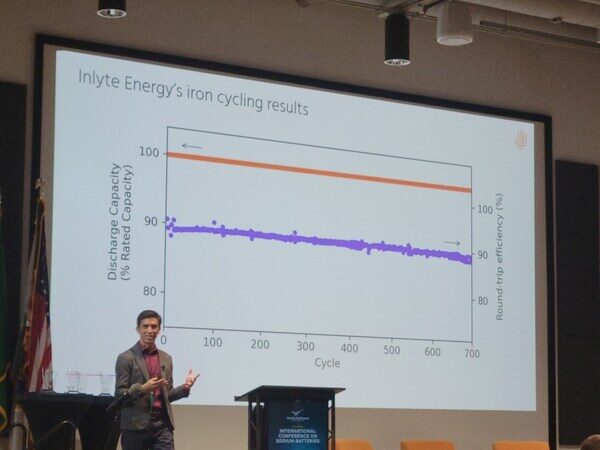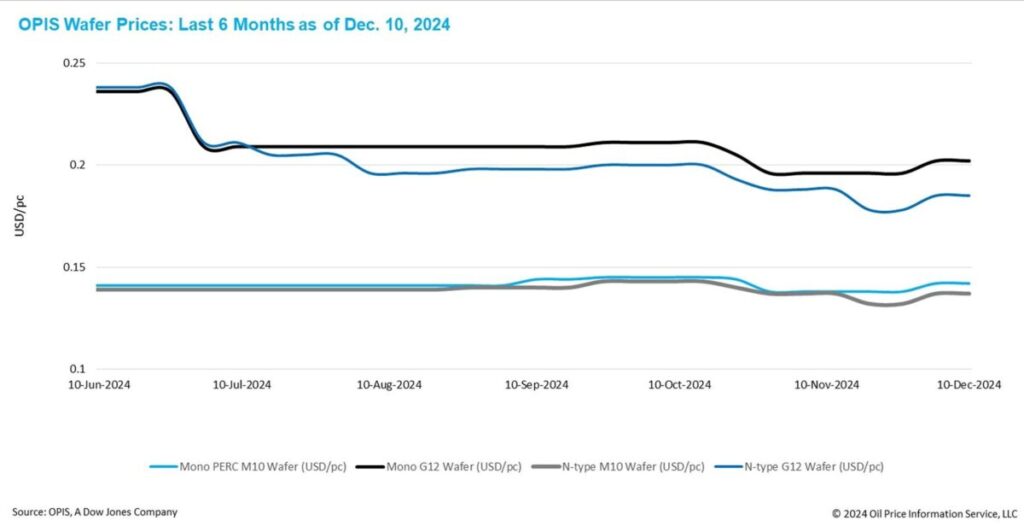In a new weekly update for pv magazineOPIS, a Dow Jones company, provides a brief overview of the major price trends in the global PV industry.
Mono PERC wafer prices in China remained stable this week, with Mono PERC M10 and G12 wafer prices at $0.142/piece and $0.202/piece, respectively. Similarly, FOB China prices for N-type M10 and G12 wafers showed no weekly changes and remained stable at $0.137/pc and $0.185/pc, respectively.
The Chinese market has made remarkable progress in reducing wafer inventory levels. Reports indicate that the overall business rate for block production in China remains below 50%. Moreover, waffle production in the country has been on a downward trajectory for three consecutive months since August. As a result, sources suggest that wafer inventories have now stabilized at normal sales levels, equivalent to approximately two weeks of production.
Nevertheless, industry insiders show limited optimism about the short-term prospects of the waffle market, citing the conclusion of the peak purchasing season. Reports indicate that some major cell manufacturers are planning to halt operations at certain facilities and begin Chinese New Year as early as December, a month ahead of schedule.
With weak end-user demand likely to continue globally in the first quarter of next year, wafer manufacturers are expected to prioritize controlling production volumes and aim to maintain price stability in the near term.
Recently, several regions have introduced new policies in the solar market that could impact wafer production or trade. In China, several solar manufacturers have signed a self-regulatory agreement aimed at controlling production capacity across the entire value chain, including polysilicon, wafers, cells and modules. Tier-1 wafer manufacturers, leading integrated producers with wafer production capabilities and major specialty wafer manufacturers have all reportedly signed the agreement. These companies have reportedly been allocated maximum allowable wafer production quotas, which collectively amount to approximately 650 GW for 2025, representing a modest 2% growth compared to 2024 levels.
Market observers generally view the signing of the self-regulation agreement and the allocation of capacity quotas as only a first step towards eliminating excessive capacity. The future implementation and effectiveness of the agreement remain uncertain and are likely to face significant challenges.
In India, the Ministry of New and Renewable Energy (MNRE) announced this week that solar projects must use cells from Schedule-II of the Approved List of Models and Manufacturers (ALMM) from June 2026. While the introduction of Schedule-II next year is expected to boost domestic production of PV cells in India, India’s limited ingot and wafer capacity could lead to higher wafer imports in the near term.
In the US, the trade representative announced this week that tariffs on imported Chinese solar wafers and polysilicon will increase from 25% to 50% effective January 1, 2025. This decision is intended to support domestic investments under the Biden-Harris administration aimed at promoting the growth of a clean energy economy.
Insiders believe this development could increase the cost of Chinese wafer exports to the US, undermining their market presence or driving up prices for solar cells and modules in the region. While U.S. wafer imports from China are already minimal due to limited domestic cell production, expanding U.S. cell production could spur Chinese companies to accelerate the establishment of overseas facilities in regions such as Southeast Asia and the Middle East.
OPIS, a Dow Jones company, provides energy prices, news, data and analysis on gasoline, diesel, jet fuel, LPG/NGL, coal, metals and chemicals, as well as renewable fuels and environmentally friendly feedstocks. It acquired assets with pricing data from Singapore Solar Exchange in 2022 and now publishes the OPIS APAC Solar Weekly Report.
The views and opinions expressed in this article are those of the author and do not necessarily reflect those of the author pv magazine.
This content is copyrighted and may not be reused. If you would like to collaborate with us and reuse some of our content, please contact: editors@pv-magazine.com.
Popular content


